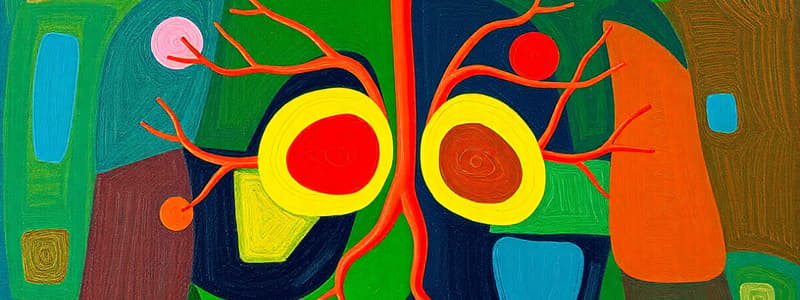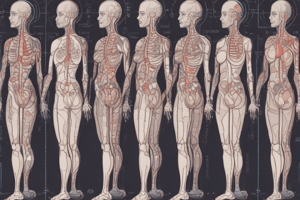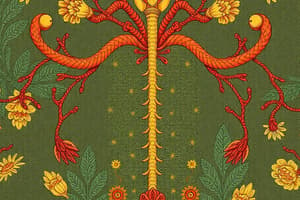Podcast
Questions and Answers
Which type of coordination involves the use of chemical messengers?
Which type of coordination involves the use of chemical messengers?
- Electrical coordination
- Mechanical coordination
- Nervous coordination
- Chemical coordination (correct)
What distinguishes exocrine glands from endocrine glands?
What distinguishes exocrine glands from endocrine glands?
- Endocrine glands secrete products into ducts; exocrine glands do not
- Endocrine glands are composed of cells, while exocrine glands are not.
- Exocrine glands secrete products into ducts; endocrine glands secrete directly into the bloodstream. (correct)
- Exocrine glands secrete hormones directly into the bloodstream
Which gland type exhibits both exocrine and endocrine functions?
Which gland type exhibits both exocrine and endocrine functions?
- Autocrine glands
- Heterocrine glands (correct)
- Exocrine glands
- Endocrine glands
What is the primary role of hormones in the body?
What is the primary role of hormones in the body?
Which hormone was the first to be discovered?
Which hormone was the first to be discovered?
Which hormone was the first to be sequenced?
Which hormone was the first to be sequenced?
Which of the following is classified as a steroid hormone?
Which of the following is classified as a steroid hormone?
Which of the following hormones is NOT an amino acid derivative?
Which of the following hormones is NOT an amino acid derivative?
Which of the following is a protein hormone?
Which of the following is a protein hormone?
Which of the following are peptide hormones?
Which of the following are peptide hormones?
Which of the following is a large polypeptide hormone?
Which of the following is a large polypeptide hormone?
Which of the following is a fatty acid derivative hormone?
Which of the following is a fatty acid derivative hormone?
What is the alternative name for the Pituitary Gland?
What is the alternative name for the Pituitary Gland?
Through what structure is the Pituitary Gland attached to the hypothalamus?
Through what structure is the Pituitary Gland attached to the hypothalamus?
What is the approximate weight of the pituitary gland?
What is the approximate weight of the pituitary gland?
How many lobes is the pituitary gland divided into?
How many lobes is the pituitary gland divided into?
Which of the following is/are lobes of the pituitary gland?
Which of the following is/are lobes of the pituitary gland?
What is the alternative name for the anterior pituitary lobe?
What is the alternative name for the anterior pituitary lobe?
Approximately how many hormones does the anterior pituitary lobe secrete?
Approximately how many hormones does the anterior pituitary lobe secrete?
Which lobe is also known as the neurohypophysis?
Which lobe is also known as the neurohypophysis?
Which of the following is released by the anterior putuitary lobe?
Which of the following is released by the anterior putuitary lobe?
What is the alternate name for STH?
What is the alternate name for STH?
Which of the following is another name for TSH?
Which of the following is another name for TSH?
What does ACTH stand for?
What does ACTH stand for?
Which of the options are types of coordination?
Which of the options are types of coordination?
Which of the followinng has a weight of 0.5 gm?
Which of the followinng has a weight of 0.5 gm?
What do hormones regulate?
What do hormones regulate?
Where are hormones secreted from?
Where are hormones secreted from?
Which of the following is true about hormone regulation?
Which of the following is true about hormone regulation?
Which of the following does not secrete protein/peptide hormones?
Which of the following does not secrete protein/peptide hormones?
Which of the following disorders does hormone dysregulation cause?
Which of the following disorders does hormone dysregulation cause?
Which is the first crystalline hormone?
Which is the first crystalline hormone?
Where are steroid hormones secreted?
Where are steroid hormones secreted?
What can be derivative of the hormones?
What can be derivative of the hormones?
What's a function of oxytocin?
What's a function of oxytocin?
Which of the following is a function of ADH?
Which of the following is a function of ADH?
What is the function of Follicle-stimulating hormone?
What is the function of Follicle-stimulating hormone?
What type of signaling is hormone signaling?
What type of signaling is hormone signaling?
Where is adrenaline produced?
Where is adrenaline produced?
Which lobe does not secrete hormones?
Which lobe does not secrete hormones?
Is hypothalamus involved in chemical coordination?
Is hypothalamus involved in chemical coordination?
Flashcards
Coordination
Coordination
Interaction between organs, cells, and tissues for vital functions.
Nervous Coordination
Nervous Coordination
Coordination via neurons or nervous system.
Chemical Coordination
Chemical Coordination
Coordination using hormones as chemical messengers.
Glands
Glands
Signup and view all the flashcards
Exocrine Glands
Exocrine Glands
Signup and view all the flashcards
Endocrine Glands
Endocrine Glands
Signup and view all the flashcards
Heterocrine Glands
Heterocrine Glands
Signup and view all the flashcards
Hormone
Hormone
Signup and view all the flashcards
Steroid Hormones
Steroid Hormones
Signup and view all the flashcards
Amino Acid Derivatives
Amino Acid Derivatives
Signup and view all the flashcards
Proteins/Peptide Hormones
Proteins/Peptide Hormones
Signup and view all the flashcards
Glycoprotein Hormones
Glycoprotein Hormones
Signup and view all the flashcards
Fatty Acid Derivatives
Fatty Acid Derivatives
Signup and view all the flashcards
Pituitary Gland
Pituitary Gland
Signup and view all the flashcards
Pituitary gland lobes
Pituitary gland lobes
Signup and view all the flashcards
Somatotrophic Hormone (STH)
Somatotrophic Hormone (STH)
Signup and view all the flashcards
Thyroid stimulating Hormone (TSH)
Thyroid stimulating Hormone (TSH)
Signup and view all the flashcards
Adrenocorticotropic Hormone (ACTH)
Adrenocorticotropic Hormone (ACTH)
Signup and view all the flashcards
Study Notes
- Coordination involves the interaction between organs, cells, tissues, and systems to perform the body's vital functions.
- Nervous coordination occurs through neurons or the nervous system.
- Chemical coordination occurs through hormones.
- Glands are cells or groups of cells responsible for specific secretions; there are two types of glands.
Exocrine Glands
- These glands secrete substances directly into a duct, not into the bloodstream.
- Examples include salivary glands, sweat glands, and lacrimal glands (tear glands).
Endocrine Glands
- These glands secrete substances directly into the bloodstream.
- Examples include the pituitary gland, thyroid gland, and adrenal gland.
Heterocrine Glands
- These glands have both exocrine and endocrine activities.
- Examples include the pancreas, liver, and testes.
Hormones
- Hormones are chemical substances secreted from endocrine glands.
- They travel through the bloodstream and regulate various bodily functions.
- Secretin was the the first hormone discovered.
- Thyroxin was the first crystalline hormone.
- Insulin was the first sequenced hormone (by Sanger in 1951).
Steroid Hormones
- Sex hormones like estrogen, progesterone, and testosterone are types of steroid hormones.
- Hormones of the adrenal cortex, such as cortisol and aldosterone, are also steroid hormones.
Amino Acid Derivatives
- Two groups of hormones are amino acid derivatives of tyrosine.
- Thyroxin (T4) and triiodothyronine (T3) of the thyroid gland are examples.
- Epinephrine and norepinephrine of the adrenal medulla are further examples.
Protein or Peptide Hormones
- Growth hormone, prolactin, ACTH, and TSH are proteins in nature and are thyroid stimulating hormones.
- Oxytocin and ADH are peptides composed of 9 amino acids each.
- ADH is also known as vasopressin.
- Insulin, glucagon, and paratharmone are large polypeptides.
- Some hormones, like FSH, LH, and erythropoietin, are glycoproteins in nature.
- Some hormones, like Prostaglandin, are fatty acid derivatives.
Pituitary Gland
- It is also known as the hypophysis and Master Gland.
- It's located on the brain and attached to the hypothalamus via a stalk called the infundibulum.
- It weighs 0.5 grams.
- It is divided into three lobes: the anterior pituitary lobe (adenohypophysis), the posterior pituitary lobe (neurohypophysis), and the middle lobe.
Anterior Pituitary Lobe
- Secretes six hormones.
- STH (Somatotrophic Hormone or Somatotropin or Growth Hormone or GH).
- TSH (Thyroid Stimulating Hormone or Thyrotropin).
- ACTH (Adrenocorticotropic Hormone or Adrenocorticotropin).
Studying That Suits You
Use AI to generate personalized quizzes and flashcards to suit your learning preferences.




